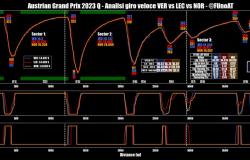The cycle of meetings “Inside the restoration” concludes at Palazzo Ardinghelli: the transformation from a noble palace to the headquarters of MAXXI L’Aquila.
In the last of the project’s appointments “Inside the Restoration”promoted by Regional Secretariat Ministry of Culture for Abruzzodedicated to Ardinghelli Palacein addition to the history and the restoration phases, we also addressed the transformation that led the ancient noble palace to be the nerve center of contemporary art, with the MAXXI L’Aquilathrough a conversation between Silvia La Pergola and Claudia RealeSenior Architects – Exhibitions Office of the MAXXI Foundation e Paola MastracciArchitect responsible for Lighting – Technical Office of the MAXXI Foundation, Franco De Vitis director of the restoration works of Palazzo Ardinghelli and designer of MAXXI L’Aquila e Carlo Lufrano safety coordinator of the restoration of Palazzo Ardinghelli and designer of MAXXI L’Aquila.
The post-earthquake restoration work just started in 2015, the minister Dario Franceschini – following an on-site visit – decided to change the intended use of the Palace, which since 2008 has been state property of the Ministry for Cultural Heritage and Activities and Tourism, proposing to host a detached section of the National Museum of 21st Century Arts – MAXXI. Thus a new need was created: reconvert work on a new project, in which the value of the conservation of cultural heritage interacts with a nascent contemporary art museum. Certainly one challenge It is no small feat to propose a separate branch of the MAXXI, the first National Museum of Contemporary Art, designed in 1998 by the Anglo-Iraqi architect in L’Aquila, and moreover in an eighteenth-century building. Zaha Hadid. The starchitect’s proposal convinced the jury for its ability to integrate into the urban fabric and for the innovative architectural solution, capable of interpreting the potential of the new institution and providing it with an extraordinary sequence of public spaces. And it is precisely this concept that is reported in the MAXXI L’Aquila: the particularity of Ardinghelli Palace, whose architecture participates in the urban system. The building was designed, in fact, to be crossed, as a sort of pass that connects via Garibaldi and piazza Santa Maria Paganica. The concept has been maintained with a view to preserving the city’s historical memory, since returns the connection even when the Museum is closed; this space is also used in the exhibition itinerary, with the presence of the site-specific work of Nuncioamong the five Italian artists exhibited at the inauguration of the MAXXI L’Aquila on May 28, 2021.
To set up the Museum, a path that was already legible in the Palace was followed, with its theory of connected rooms and the telescope-like stringing of doors, which leads towards the heart of the upper floor, the hall onto which the view opens onto the square. A fundamental role in the exhibition rooms is played by light, both the natural one that enters from the imposing windows, and the artificial one, used directly with spotlights positioned on a system of tracks (the Blindo) and indirectly, with the LED strips that diffusely illuminate the rooms. The use of mobile floor lamps and tracks suspended from the ceiling has once again allowed maximum respect for the historic building, with a view to dialogue between ancient and contemporary which can be seen in every room of the Museum and which culminates in the work of Ettore Spalletti, Column in the voidcreated for the palace chapel.
A few years after its inauguration, MAXXI has become cultural heart of the cityrooted in the territory, but with an international and multidisciplinary slant, which has finally given Palazzo Ardinghelli that long unjustly forgotten identity.
At the end of the series of meetings “Inside the Restoration” the experience is summed up. “A heartfelt participation, for which we thank all those who attended the meetings – declares the Regional Secretary, Doctor Matteo Pisi –. I have recently been in the city, and I have had the opportunity to get to know some of its most important monuments and to appreciate the work carried out in recent years, with great competence, by the Ministry’s technicians, for the recovery of the monumental heritage”. We thank Professor for his fundamental technical-scientific contribution and support to the organization Michele MaccheriniDon Martino Gajdadoctor Saverio Ricci, Sofia Leocata, Father Francesco and the Community of Friars Minor of San Giuliano, Silvia La Pergola, Paola Mastracci, Claudia Reale, Franco De Vitis, Carlo Lufrano, Paolo Le Grazie. The project was carried out in collaboration with the Department of Human Sciences of the University of L’Aquila, the Superintendence of Archaeology, Fine Arts and Landscape for the provinces of L’Aquila and Teramo, the Friars Minor of San Giuliano and AquilArtes, and the MAXXI L’Aquila. Project staff: Silvia Taranta, Assunta Serchia, Giovanna Spinelli (ALES SpA), Giulia Sulliwith the collaboration of Maria Rita Copersino and Massimiliano Tesone.
In addition to Palazzo Ardinghelli, the project examined two other places of identity for L’Aquila: the Church of San Silvestro with the history of Branconio Chapel and the interweaving of spirituality and art contained in the Convent and Convent of San Giuliano.









